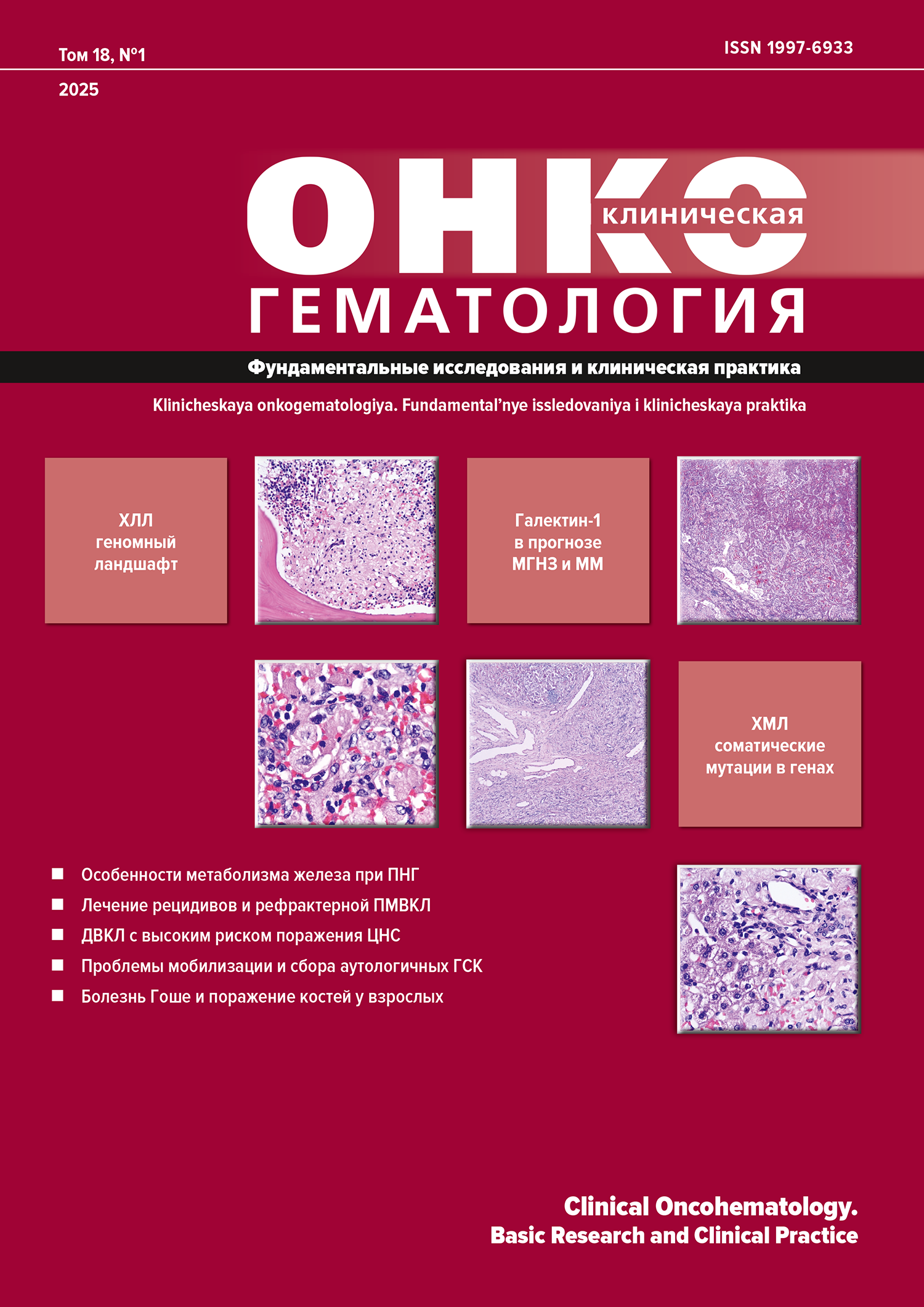Abstract
BACKGROUND. Although highly effective enzyme replacement therapy (ERT) for Gaucher disease (GD) is accessible and affordable, orthopedic issues in patients appear often to be the main factor leading to their disability. Bone lesions are essentially observed in 100 % of GD patients. The nature and severity of bone and joint changes, however, are reported to be extremely heterogeneous, whereas their incidence and clinical features have until now remained underresearched.
AIM. To assess the incidence and clinical value of bone and joint lesions which complicate the course of GD type 1 with bone involvement.
MATERIALS & METHODS. This trial enrolled 267 GD type 1 patients aged 17–85 years (median 38 years), who were followed-up at the National Research Center for Hematology from 2004 to 2024. There were 109 men and 158 women. The analysis focused on the following MRI findings: bone marrow infiltration (BMI), Barnett-Nordin cortical index (BNI), bone deformity, osteolytic and osteonecrotic lesions, as well as orthopedic pathologies progressing to disability.
RESULTS. BMI was identified in 213/267 (79.8 %) patients. Erlenmeyer flask-like femoral expansion was observed in 95 % patients (n = 254). The mean BNI was 42.9 % (the normal BNI in adult population exceeds 45 %). Low BNI values were associated with osteolytic lesions, disability, and BMI. No significant association of decreased BNI was seen with osteonecroses. The incidence of osteolytic lesions was 11.2 % (n = 30). New osteolytic lesions were reported neither in ERT nor in substrate reduction therapy recipients. Medullary osteonecrosis was detected in 206/267 (77.15 %) patients, and epiphyseal osteonecrosis was identified in 74/267 (27.72 %) patients. Along with osteonecroses, in contrast to osteolytic manifestations, new lesions (n = 8) were reported to occur under long-term (> 5 years) ERT. The rate of bone fractures was 6.7 % (n = 18). In 18 patients, 64 fractures were observed at various locations. Disability associated with bone and joint complications of GD occurred in 58/267 (21.72 %) patients. After reconstructive surgery, including total articular replacement arthroplasties, 37 patients achieved complete functional recovery.
CONCLUSION. Bone changes are essentially observed in all adult patients with GD type 1. However, clinical severity and disability of patients depend on secondary bone and joint complications, among them arthroses resulting from epiphyseal osteonecrosis, pathologic fractures, bone and joint infections. These complications developing on effective ERT were identified in 67/267 patients, which accounted for 25 %.
References
- 1. Лукина Е.А. Болезнь Гоше. 10 лет спустя. М.: Практическая медицина, 2021. 56 с. [Lukina E.A. Bolezn’ Goshe. 10 let spustya. (Gaucher disease. 10 years later.) Moscow: Prakticheskaya Meditsina Publ.; 2021. 56 p. (In Russ)]
- 2. Пономарев Р.В., Лукина К.А., Сысоева Е.П. и др. Поддерживающий режим заместительной ферментной терапии у взрослых больных болезнью Гоше I типа: предварительные результаты. Гематология и трансфузиология. 2019;64(3):331–41. doi: 10.35754/0234-5730-2019-64-3-331-341. [Ponomarev R.V., Lukina K.A., Sysoeva E.P., et al. Reduced dosing regimen of enzyme replacement therapy in adult patients with type I Gaucher disease: preliminary results. Russian journal of hematology and transfusiology. 2019;64(3):331–41. doi: 10.35754/0234-5730-2019-64-3-331-341. (In Russ)]
- 3. Futerman AH, Zimran A. Gaucher disease. Boca Raton: CRC Press Taylor & Francis Group; 2007.
- 4. Deegan PB, Pavlova E, Tindall J, et al. Osseous manifestations of adult Gaucher disease in the era of enzyme replacement therapy. Medicine (Baltimore). 2011;90(1):52–60. doi: 10.1097/MD.0b013e3182057be4.
- 5. Hughes D, Mikosch P, Belmatoug N, et al. Gaucher Disease in Bone: From Pathophysiology to Practice. J Bone Miner Res. 2019;34(6):996–1013. doi: 10.1002/jbmr.3734.
- 6. Пономарев Р.В. Динамика лабораторных показателей, отражающих функциональную активность макрофагальной системы, у пациентов с болезнью Гоше I типа на фоне патогенетической терапии: Автореф. дис. … канд. мед. наук. М., 2020. С. 1–24. [Ponomarev R.V. Dinamika laboratornykh pokazatelei, otrazhayushchikh funktsionalnuyu aktivnost’ makrofagalnoi sistemy, u patsientov s bolezn’yu Goshe I tipa na fone patogeneticheskoi terapii. (Dynamics of laboratory parameters reflecting the activity of the macrophage system in patients with Gaucher type I disease against the background of pathogenetic therapy.) [dissertation] Moscow; 2020. pр. 1–24. (In Russ)]
- 7. Mehta A. Epidemiology and natural history of Gaucher’s disease. Eur J Intern Med. 2006;17(Suppl):S2–S5. doi: 10.1016/j.ejim.2006.07.005.
- 8. Лукина Е.А., Сысоева Е.П., Лукина К.А. и др. Болезнь Гоше у взрослых: диагностика, лечение и мониторинг. М.: Практика, 2018. C. 411–25. [Lukina E.A., Sysoeva E.P., Lukina K.A., et al. Bolezn’ Goshe u vzroslykh: diagnostika, lechenie i monitoring. (Gaucher disease in adults: diagnosis, treatment, and monitoring.) Moscow: Praktika Publ.; 2018. pp. 411–25. (In Russ)]
- 9. Лукина Е.А., Сысоева Е.П., Мамонов В.Е. и др. Клинические рекомендации по диагностике и лечению болезни Гоше. М.: Национальное гематологическое общество, 2014. 21 с. [Lukina E.A., Sysoeva E.P., Mamonov V.E., et al. Klinicheskie rekomendatsii po diagnostike i lecheniyu bolezni Goshe. (Clinical guidelines for the diagnosis and treatment of Gaucher disease.) Moscow: Natsionalnoe Gematologicheskoe Obshchestvo Publ.; 2014. 21 p. (In Russ)]
- 10. Zimran A. How I treat Gaucher disease. Blood. 2011;118(6):1463–71. doi: 10.1182/blood-2011-04-308890.
- 11. Соловьева А.А., Костина И.Э., Пономарев Р.В. и др. Болезнь Гоше: лучевая диагностика костных проявлений. М.: ГЭОТАР-Медиа, 2024. 104 c. [Soloveva A.A., Kostina I.E., Ponomarev R.V., et al. Bolezn’ Goshe: luchevaya diagnostika kostnykh proyavlenii. (Gaucher disease: radiological diagnosis of bone manifestations.) Moscow: GEOTAR-Media Publ.; 2024. 104 p. (In Russ)]
- 12. Соловьева А.А., Яцык Г.А., Пономарев Р.В. и др. Обратимые и необратимые изменения костно-суставной системы при болезни Гоше I типа. Гематология и трансфузиология. 2019;64(1):49–59. doi: 10.35754/0234-5730-2019-64-1-49-59. [Soloveva A.A., Yatsyk G.A., Ponomarev R.V., et al. Reversible and irreversible radiological signs of bone involvement in type I Gaucher disease. Russian journal of hematology and transfusiology. 2019;64(1):49–59. doi: 10.35754/0234-5730-2019-64-1-49-59. (In Russ)]
- 13. Mikosch P, Hughes D. An overview on bone manifestations in Gaucher disease. Wien Med Wochenschr. 2010;160(23–24):609–24. doi: 10.1007/s10354-010-0841-y.

This work is licensed under a Creative Commons Attribution-NonCommercial-ShareAlike 4.0 International License.
Copyright (c) 2025 Clinical Oncohematology

